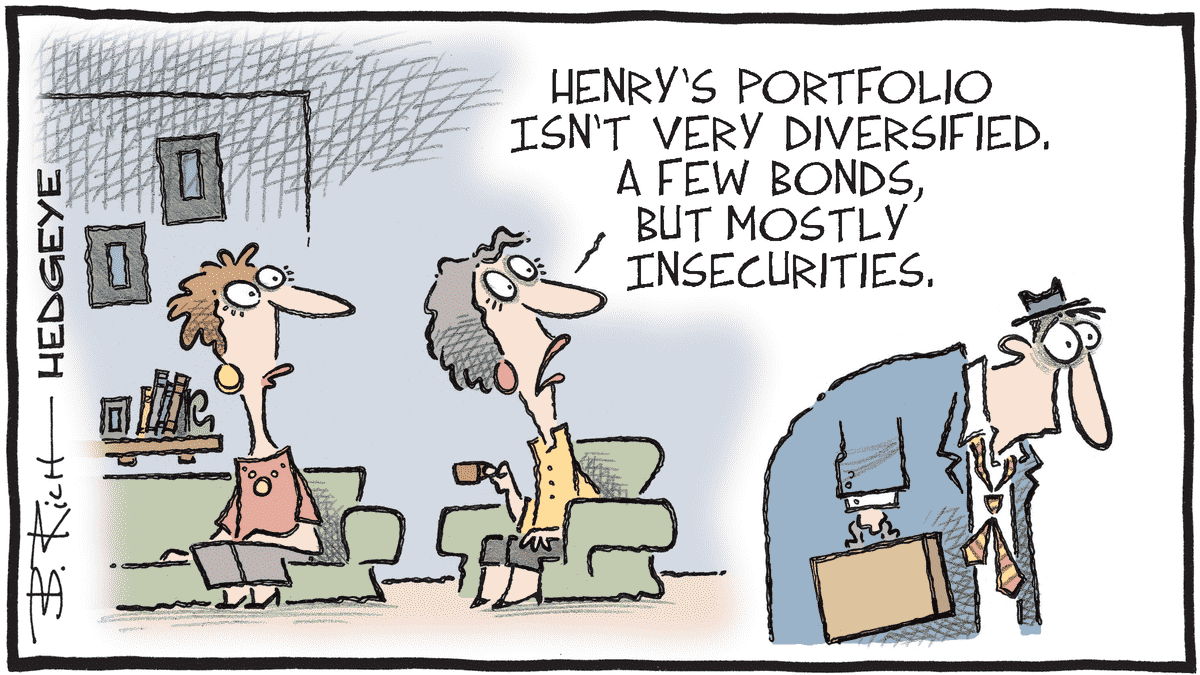
Second consecutive session of optimism on global stock markets, all thanks to the methods of Trumponomics. Slap on tariffs left and right, terrify the market, pick fights with everyone—and three days later, it’s all “raw potato, raw tactics.” And the markets bounce back because they’re SO, SO happy that there’s talk of de-escalation with China and that, in the end, Powell isn’t being fired. The word most often heard this morning is: RELIEF. Now we just need Trump not to pull another stunt in the next 24 hours, and we might actually end the week not too badly—for once.
Volatility
The question is how much longer this circus is going to last. Let’s not kid ourselves—volatility might be fun if you’re trading, but it’s pretty annoying when you don’t know how you’re going to get eaten tomorrow. Not just tomorrow, but especially MID-TERM. You don’t need to be a rocket scientist to realize that the companies publishing results right now are totally lost and incapable of making the slightest forecast about the future—and that inevitably affects investor behavior. No vision: no money.
Trump has been going on about his MAGA—Make America Great Again—for over a year now, and the only thing he’s actually achieved is more of an MVGA: Make Volatility Great Again. We’ve been tossed around non-stop since January, and to be honest, I think we preferred the good old days when artificial intelligence was “so awesome” and gained 12% a day, every day, and no one gave a damn about the macroeconomy—because, you know, Nvidia. Rather than the current period, where we’re forced to live at the mercy of statements from a BIPOLAR President with a terrible haircut. Anyway, for now, we have no choice but to go along with Donald Trump’s three-step waltz, which always follows the same pattern:
-
He threatens
-
He imposes more tariffs – The market crashes
-
He announces “progress” or pauses the tariffs – The market rebounds
-
Since there’s still no real progress or trade deal: he threatens again…
-
He imposes more tariffs – The market crashes
-
You know the drill…
That’s what we might call the “virtuous circle” of Trump’s policy. Though I’m not sure “virtuous” is quite the right word here, since according to Wikipedia, in economics, a virtuous cycle is a chain of positive events. In this case, it’s more a sequence of press releases that make no sense, sow doubt everywhere, and have us spinning in circles. But hey, yesterday the markets went back up because Trump’s words were “reassuring.” Reassuring in the sense that he’s making a gesture toward the Chinese, and reassuring in the sense that he’s not firing Powell or undermining the Fed’s independence. For now. Referring back to the cycle above, we’re currently at step 3. The weekend is 36 hours away, and I’m willing to bet he’s going to pull some crap before Monday morning!!!
Europe Gone Wild
The good news announced overnight from Tuesday to Wednesday allowed European markets to rise again and forget about Monday’s session. Let’s not say there was euphoria, but relief could definitely be felt. Relief, along with some decent quarterly numbers. In Germany, SAP carried the entire index on its back—their excellent results and out-of-this-world guidance pushed the rest of the tech sector upward, even though the PMI figures showed a fresh contraction in the German economy (but who cares, there’s loads of money pouring in). And despite the fact that Germany’s export-driven growth model is facing serious challenges. The good news: Trump’s mess hasn’t yet caused a major slowdown in the manufacturing sector. For now. The DAX closed up over 3%. Worth noting: since the lows of April 7, the German index has gained 19%. That figure alone—and the speed of the rise—speaks volumes about the mental state of the markets.
In Paris, it was total madness with a big sigh of relief (there too). Between Trump relaxing and China declaring that their doors were “wide open,” you couldn’t ask for more. For now. Yesterday’s figures were a mixed bag: on one hand, Eurofins confirmed its annual targets, saying U.S. tariffs shouldn’t affect costs, while also expressing caution in this “uncertain economic climate.” Understandably so. But the market didn’t care about the caution—the stock soared 12%. On the flip side, Kering’s figures weren’t great. They repeated the same story from previous quarters: Gucci’s not doing well, traffic in their stores is down—especially Gucci. Well, when you see how ugly some of it is, you don’t really want to walk into the store—even from the window. Still, the stock ended up nearly 3% higher because “you know, Trump relaxed.” He didn’t buy Gucci sneakers, but he relaxed.
In Switzerland and in Courtrooms
Switzerland followed the trend, with Logitech trying to rebound amid better U.S. sentiment. UBS gained 4.4% because of new partnerships with India. Today, we’ll keep an eye on the quarterly results of Roche, Nestlé, and Kühne + Nagel.
Another topic, which didn’t really matter to the markets: the European Commission fined Apple €500 million and Meta €200 million for violating the DMA—the Digital Markets Act, for those familiar. This legislation aims to curb the power of big digital platforms and protect European consumers. Ah yes, regulation: Europe’s specialty. While the Americans and the rest of the world charge ahead with innovation, Europe focuses on regulation.
So yesterday, the European Commission had a bit of a tantrum and slapped Apple and Meta with fines. Apple was punished for restricting app developers from promoting alternatives to the App Store—a practice that limits competition. Meta was called out for its “consent or pay” model, which forces users to choose between sharing their personal data for targeted ads or paying for an ad-free version. The Commission considers that this binary choice violates consumer rights. Apple and Meta now have 60 days to comply with the DMA or face further penalties. In conclusion: a €500 million fine for Apple is a drop in the ocean. However, it will be interesting to see whether the White House could use this sanction as a pretext to impose tariffs. To be continued.

Elsewhere in the World
This morning, Asia is divided. After opening higher across the board, Shanghai and Hong Kong slipped back into the red. Japan is up 1%, and the favorite theme of the moment remains “de-escalation.” As a result, gold took a hit yesterday—after reaching $3,500, the yellow metal suddenly deflated. It’s making headlines in some media outlets because, believe it or not, gold can go down. Currently, it’s sitting at $3,337 an ounce. Oil is at $62.86, and Bitcoin has pushed past $92,000. People are starting to talk about it again.
Over in the US
Last night, we got the Beige Book release. Let’s be honest: most of the time, nobody cares. Nobody cares, and that’s still the case, as it went almost completely unnoticed. But I want to take a moment to talk about it because the content is actually quite interesting. Interesting because, despite all the reassuring speeches, the US economy is showing signs of weakness. The latest Fed Beige Book shows slowing economic activity, growing inflationary pressures, and rising uncertainty linked to the trade policies of you-know-who.
The Beige Book—this classic report where central bankers tell us what they see through the tinted windows of their air-conditioned offices. And this time, the picture isn’t exactly an ad for the American Dream.
Let’s start with economic activity, described as “stable,” but weakly so. Weakly stable??? I don’t even want to imagine what that’s supposed to mean. Out of the Fed’s 12 districts, only 5 dared to say they saw a bit of growth. Not fireworks—just a “slight improvement,” like moving from crutches to a walker. While general consumption is heading for the ICU, car sales are booming… but not because people are suddenly rich and ordering Ferraris and Porsches in multipacks. No: they’re panicking that Trump’s tariffs will send prices skyrocketing. So they’re buying now—while it’s still cheap—because they’re scared. Nice.
Next up: inflation. Prices are rising, surprisingly enough, slowly but surely—or, as the Fed puts it, “moderately.” But pressure is building, especially on goods coming from outside the US. Companies already have their fingers on the price-hike trigger, ready to pull it the moment Trump gets louder on China. So yes, inflation might look “calm,” but it’s doing push-ups every morning to be ready when the time comes.
Employment? Less bad than expected… but still not great. There are layoffs, but it’s “soft.” On the flip side, companies are hiring more easily—either a good sign or an indication that people are so scared they’ll take any job. Except in technical fields, where competition is still fierce. So yes, knowing how to code or fix a robot still pays off.
Chapter 4 of this Beige Book: “UNCERTAINTY.” The word appears 80 times in the report—no joke. That gives you an idea of how lost American businesses feel.
Between Trump blowing hot, cold, then napalm, and back to hot and cold, interest rates zigzagging, and supply chains dancing the macarena, business leaders have stopped investing. They’re clenching their teeth and cheeks and just hoping it’ll all pass.
Tourism is also plummeting. Canadians aren’t coming anymore, business travel has been massively cut, and conferences are now Zoom or Google Meet sessions. In short, meetings are in recession. As for tourists, it’s not a good look these days to vacation in Trump-land (though I’m willing to sacrifice myself and go check it out this summer just to be sure).
Conclusion
Welcome to America—“not quite a disaster, but close.” The April 2025 Beige Book is like a medical report that says: “You’re not dying, but you’re far from healthy.” The Fed now has to walk a tightrope: don’t spook the markets, don’t trigger inflation, don’t make the weak growth worse, and above all, don’t unleash the nasty cousin from the ’70s—stagflation. Because if we tip into that… even Powell won’t have any magic tricks left.
In Other News
As mentioned at the top of this update, we never know when Trump will land another punch. Last night, he said he might lift the moratorium introduced a few days ago—but only for certain countries. He also took another swipe at Powell, saying the Fed chair should lower rates and hinted he might give him a call. In short, the guy goes in every direction—hot, cold, then back again within 24 hours. If you’re thinking of jumping into the markets today, a full-face helmet and gloves might be wise.
Also worth noting: very strong numbers from Hynix in Korea, one of Nvidia’s major suppliers. Results are solid, though order volatility is pretty wild, they say. Boeing also posted numbers that were “less bad” than feared—hence yesterday’s gain. And The Wall Street Journal says today’s market volatility is the “new normal” under Trump 2.0. Fun.
Today’s Numbers
On today’s agenda, there’s plenty going on in Switzerland. In the US, we’ll hear from PepsiCo, Southwest, and American Airlines—all cautious about tourism. We’ll also get earnings from Intel and Alphabet after market close. In Europe: Sanofi, Thales, Air Liquide, Saint Gobain, Nokia, Accor, Renault… a whole bunch of names and a mountain of interpretation to do.
On the macro side: IFO in Germany, Durable Goods in the US, and Jobless Claims.
For now, futures are down 0.20%, and frankly, it feels like everyone’s just waiting for the next slap… especially after two days of gains.
Have a great day, and see you tomorrow!

